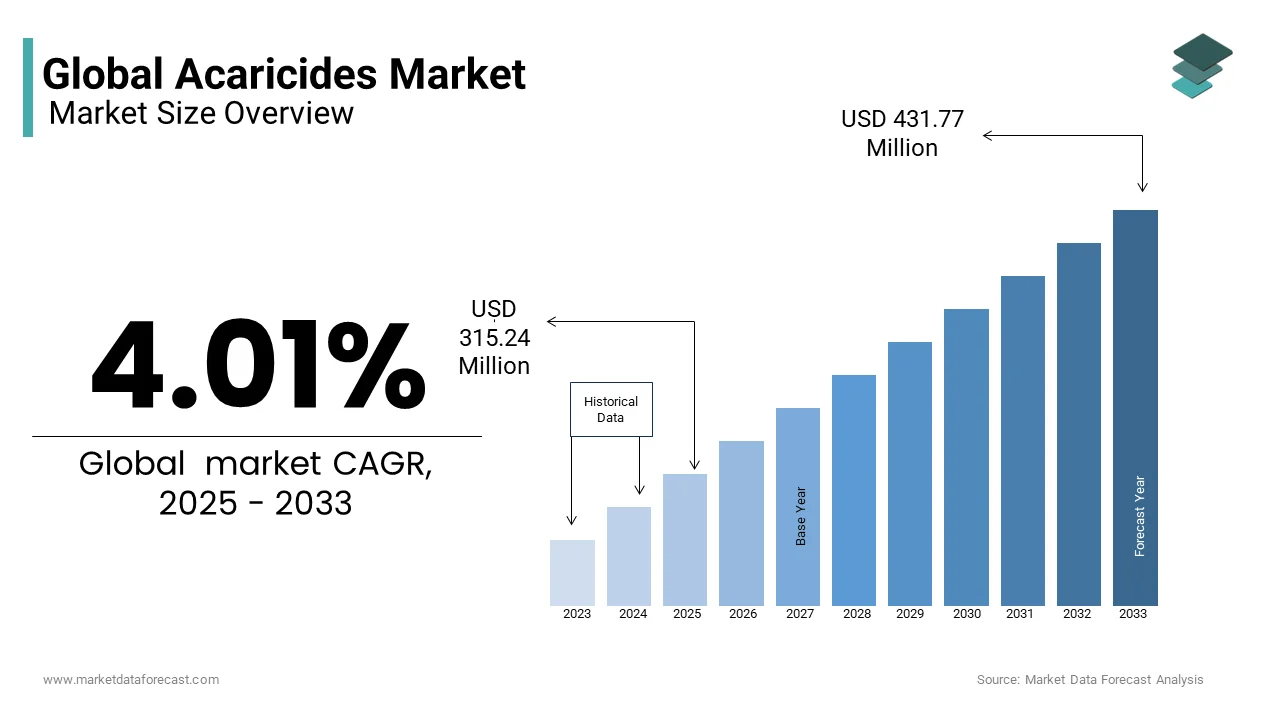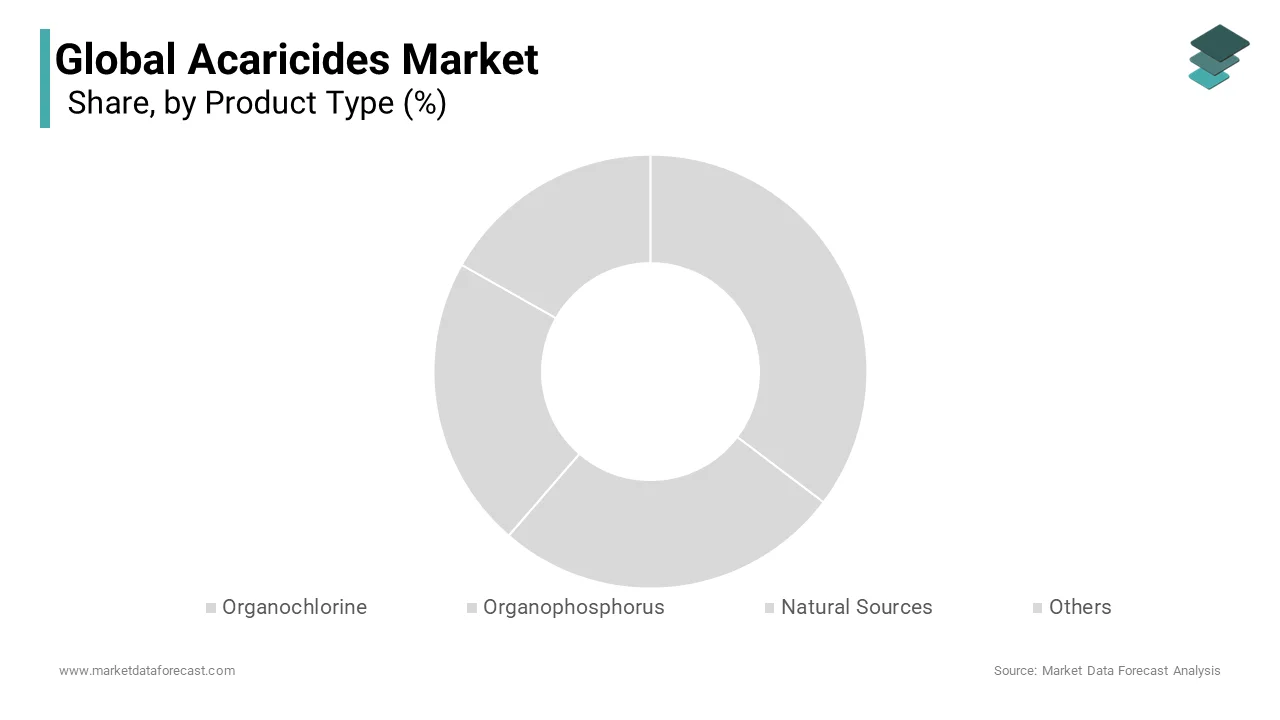Global Acaricides Market Size, Share, Trends, & Growth Forecast Report, Segmented By Type (Organochlorine, Organophosphorus, Natural Sources, And Others), Application (Agriculture, Animal Husbandry, Industrial, And Others), Mode Of Action (Spray, Dipping Vat, Hand Dressing And Others), And Region (North America, Europe, APAC, Latin America, Middle East And Africa), Industry Analysis From 2025 To 2033
Global Acaricides Market Size
The global acaricides market was valued at USD 303.09 million in 2024 and is anticipated to reach USD 315.24 million in 2025 from USD 431.77 million by 2033, growing at a compound annual growth rate (CAGR) of 4.01 % during the forecast period from 2025 to 2033.

Acaricides are pesticides that kill members of the Arachnid subclass Acari, which includes ticks and bugs. Acaricides are utilized both in Medicine and Agriculture, although the desired power contrasts between the two fields. There are various types of acaricides based on the amount of various chemicals such as zinc, tin, phosphorus, and chlorine. Acaricides are also produced from natural raw materials such as spoiled corn, clove, and neem. These naturally created acaricides tend to be less poisonous. Chemically derived acaricides include organophosphorus and organochlorine.
Current Scenario Of The Global Acaricides Market
In today’s fast-moving agricultural technology landscape, innovating and developing pesticides is essential for promoting healthy crop growth and increasing agricultural productivity. The acaricides market is steadily moving forward. Moreover, sustainable agriculture is becoming more important, resulting in a rising demand for eco-friendly options. Farmers are increasingly looking for natural and organic solutions to control pests while reducing their impact on the environment.
MARKET DRIVERS
The Major Driving factors in this market are the rise in efficiency, developments in the crop protection industry, and the rise in demand for meat and dairy products.
A significant propellant is the growing demand for improved agricultural efficiency. Farmers are constantly challenged to increase their yields and reduce losses from pests. It serves as an effective tools for managing these pests, leading to healthier crops and better productivity. As farming techniques evolve, the development of advanced formulations and application methods has made insect or plague management more efficient. This boost in effectiveness not only allows farmers to produce more but also cuts down on pest control expenses, solidifying acaricides as essential in modern agriculture.
The market growth is also fuelled by the new developments in the crop protection field. Ongoing research is yielding innovative active ingredients and formulations that are proving to be more effective against pests that have developed resistance.
MARKET RESTRANTS
The main restraints of the industry are regulatory restrictions, alternative acaricide sources, and the rising cost of raw materials. Acaricides are expensive because they are costly and time-consuming to develop, and ticks rapidly acquire immunity to them. According to a study published in the PubMed under the National Library of Medicine, farms that utilise advanced technology tend to spend less on tick control, with only 13.41 per cent of their sanitary expenses going toward it, compared to 23.97 per cent for semi-technified ranches or farmhouses and 32.49 per cent for non-technified ones. Likewise, those with better technology and larger herds have lower annual acaricide treatment costs.
MARKET OPPORTUNITIES
Biological acaricides present key opportunities for the expansion of this market. They have huge potential, particularly animal-based acaricides and microbiological acaricides, as there is limited research in the field. As per a study, there are countless plant species in the world, i.e., over 2,400, that can be employed to help control harmful organisms. Reportedly, about 1,000 of these can effectively manage pests, and around 100 are specifically useful for tackling mites. Besides this, the market will greatly benefit from the discovery of new agents for control. For instance, the findings of the investigation suggest that plant essential oils could play a valuable role in research focused on developing new pest control agents from medicinal plants.
MARKET CHALLENGES
The development of practical and affordable solutions is one of the primary challenges decelerating the growth rate of the acaricides market. The development teams of the market players are required to create a solution that is not only effective but also realistic and cost-effective for farmers. This is crucial because producers generally operate under tighter budgets and require products that do not significantly increase their costs. Thus, balancing efficacy with affordability is essential for market growth, acceptance, and widespread use.
Selectivity for natural enemies also hinders market growth. It's quite challenging to formulate a product that can specifically target pests while protecting beneficial organisms. This exclusiveness is essential for maintaining a healthy ecological balance in agriculture.
REPORT COVERAGE
|
REPORT METRIC |
DETAILS |
|
Market Size Available |
2024 to 2033 |
|
Base Year |
2024 |
|
Forecast Period |
2025 to 2033 |
|
CAGR |
4.01% |
|
Segments Covered |
By Type, Application, Mode of Action, And Region |
|
Various Analyses Covered |
Global, Regional and Country Level Analysis; Segment-Level Analysis; DROC; PESTLE Analysis; Porter’s Five Forces Analysis; Competitive Landscape; Analyst Overview of Investment Opportunities |
|
Regions Covered |
North America, Europe, APAC, Latin America, Middle East & Africa |
|
Market Leaders Profiled |
BASF SE, Bayer AG, FMC Corporation, DuPont, Nissan Chemical Industries. Ltd., Syngenta, Merck & Co., Inc., The Dow Chemical Company, Chemtura Corporation, Arysta Life Science Limited. |
SEGMENT ANALYSIS
By Type Insights
The organophosphorus segment is the leading category of the acaricides market. This type of acaricide is frequently seen as a top choice in the market because of its effectiveness and versatility. The segment’s market share increased owing to its targeting of the nervous systems of pests, which makes it particularly effective against various mites and ticks. Their quick action and shorter environmental persistence compared to other chemical types also make them popular among farmers.

On the other hand, the natural sources segment is also gaining traction. There is a noticeable uptick in interest surrounding natural acaricides, especially those made from plant extracts and essential oils.
By Application Insights
The agriculture segment is the dominant application in the acaricides market. Farmers depend on these products to tackle pests that can harm their crops, such as different types of mites and ticks. Nowadays, many farming practices combine acaricides with biological control methods and cultural techniques as part of integrated pest management strategies. This comprehensive approach not only improves pest control effectiveness but also reduces environmental impact.
Whereas, in animal husbandry, acaricides are vital for managing parasites such as ticks and mites that can impact the health of livestock. Healthy animals are essential for productivity in this field, so using acaricides effectively is very important.
By Mode of Action Insights
The spray segment holds the maximum share of the acaricides market. It is generally regarded as the go-to method for applying this pesticide. This approach provides wide coverage and is suitable for a variety of crops and situations, making it a highly effective option for managing pests such as ticks and mites.
The dipping vats segment also accounts for a notable share of the market. It is mainly used in animal husbandry, allowing livestock to be immersed in acaricide solutions to tackle external parasites.
REGIONAL ANALYSIS
Asia Pacific dominates the Acaricides market, followed by Europe and North America. Asia Pacific is expected to retain its market share during the next few years, owing to the growth of the agriculture and animal husbandry sectors. One of the key markets in the APAC region is China. According to the latest data, China witnessed the launch of fewer than 30 new pesticides, with only 5 achieving annual sales exceeding RMB100 million. Among these, two were created by agricultural research organisations, which as key players in driving pesticide innovation and industrial change in China.

Europe follows after Asia-Pacific with the second-highest share. Further, it is expected to have a higher CAGR than North America.
Latin America is emerging as one of the key acaricide markets, holding a huge potential in this field. Market players continue to increase the frequency of investment for the development of innovative products.
In November 2024, Alta Defensivos introduced Vilora acaricide to the market in Brazil, sending the message of consistently developing and understanding the requirements of rural producers in the country. It is a durable solution created to control pests in essential crops like citrus and coffee. This product effectively manages different types of mites, including leprosy and red mites in coffee, and a range of mites such as purple, red, false rust, leprosy, and white mites in citrus, as well as coconut necrosis mites found in coconuts.
RECENT HAPPENINGS IN THE GLOBAL MARKET
- In November 2024, Sinocham Crop Care at the Hefei event held in Anhui Province revealed its state-of-the-art crop protection solution, which also had the assistance of its subsidiary, Yangnong Chemical. Moreover, at the event, Yangnong also announced the introduction of a range of unique compounds, comprising 2050, 2184, and 1877, indicating a strong course for pesticide advances in China. The focus of the company’s innovative offerings not only serves the domestic market but also holds the robust potential to compete at the global level.
- In April 2024, Bayer declared that it had agreed with AlphaBio Control, a United Kingdom-based company, to obtain the sole and only holder of a new biological insecticide. The latest item will be initially available for cultivable crops, comprising cereals and oilseed rape. This new insecticide, discovered by AlphaBio, is slated for its first launch in 2028, awaiting further development and regulatory approval. Bayer distributes FLiPPER, an award-winning bioinsecticide.
KEY MARKET PLAYERS
The major key players operating in this market are BASF SE, Bayer AG, FMC Corporation, DuPont, and Nissan Chemical Industries. Ltd., Syngenta, Merck & Co., Inc., The Dow Chemical Company, Chemtura Corporation, Arysta Life Science Limited.
MARKET SEGMENTATION
This research report on the global acaricides market has been segmented and sub-segmented based on type, application, mode of action, and region.
By Type
- Organochlorine
- Organophosphorus
- Natural Sources
- Others
By Application
- Agriculture
- Animal Husbandry
- Industrial
- Others
By Mode of Action
- Spray
- Dipping Vat
- Hand Dressing
- Others
By Region
- North America
- Europe
- Asia-Pacific
- Latin America
- Middle East & Africa
Frequently Asked Questions
1. What factors are driving the growth of the acaricides market?
The growth of the acaricides market is primarily driven by factors such as increasing demand for food safety and quality, rising prevalence of pest infestations in agriculture, and the need for effective pest management solutions.
2. What are some challenges faced by the acaricides market?
Some of the challenges faced by the acaricides market include regulatory restrictions on the use of certain chemical ingredients, environmental concerns related to pesticide use, and the development of resistance in target pests.
3. What are the key trends shaping the acaricides market?
Key trends in the acaricides market include the development of eco-friendly and organic acaricides, advancements in formulation technology for improved efficacy and safety, and the adoption of integrated pest management practices.
4. What are the growth prospects for the acaricides market in the coming years?
The acaricides market is expected to witness steady growth in the coming years, driven by increasing demand for pest control solutions in agriculture, growing awareness about the importance of pest management, and the development of new and innovative acaricides formulations.
Access the study in MULTIPLE FORMATS
Purchase options starting from
$ 2500
Didn’t find what you’re looking for?
TALK TO OUR ANALYST TEAM
Need something within your budget?
NO WORRIES! WE GOT YOU COVERED!
Call us on: +1 888 702 9696 (U.S Toll Free)
Write to us: sales@marketdataforecast.com